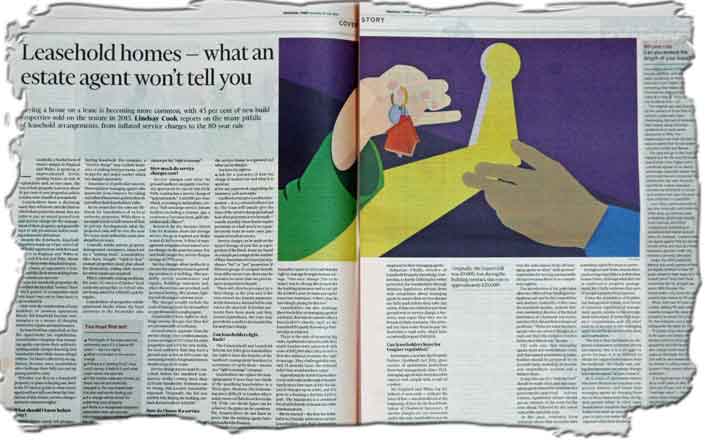 Leasehold properties make up 43 per cent of all new-build registrations with the Land Registry for England and Wales, and 3,000 of those were for leasehold houses.
Leasehold properties make up 43 per cent of all new-build registrations with the Land Registry for England and Wales, and 3,000 of those were for leasehold houses.
That is one of the findings in the Financial Times’s three-page cover story in its FTMoney section, published this weekend.
The article, written by personal finance veteran Lindsay Cook – formerly of the Telegraph – is a brilliant overview of all the current issues facing leaseholders.
She even had a section on the Court of Appeal challenge to the methodology used to value short-term leases in the incredibly lucrative lease extension racket.
The current method was commissioned by the Grovesnor estate in 1996 – that is the Duke of Westminster, the country’s richest single freehold owner whose aristocratic ancestor had the good sense to marry Mary Davies, the daughter of a scrivener (scribe) but also heiress to a 500-acre farm on which today stands Mayfair and Belgravia. (See historical footnote below)
Chartered surveyor James Wyatt, of Parthenia Limited, is challenging this cosy, insiders’ carve-up with a more robust mathematical methodology. It was reported on LKP here
The FT, which is widely read abroad and by foreign nationals working in the City, adds up to a devastating criticism of the leasehold flat ownership in England and Wales.
It is headed: “Leasehold homes – what an estate agent won’t tell you”.
Proclaiming in its first line that leasehold is “a feudal form of tenure unique to England and Wales [that is] growing at unprecedented levels”, the article points out that 95 per cent of new build in London is leasehold.
“Leaseholders have a declining asset; they will never own the land on which their properties stand, they are liable to pay an annual ground rent and service charge for the management of their property, and generally have to ask permission before making substantial alterations.”
Leasehold became widespread after the war with modern housing, it said:
“As leasehold has expanded, so has the opportunity for exploitation.
“Leaseholders complain that managing agents can abuse their authority, making unfair charges knowing that leaseholders have little means of legal redress.
“Yet there is effectively no regulation. In some cases, who challenge their bills can end up paying punitive costs.”
 The article mentions the appalling issues facing Oxford City Council leaseholders who are having to pay £50,000 each for repairs to their block.
The article mentions the appalling issues facing Oxford City Council leaseholders who are having to pay £50,000 each for repairs to their block.
It mentions a flat for sale at One Hyde Park, the most expensive apartment block in the country, which has service charges of £161,000 a year.
Average service charges are £1,863, according to insurers Direct Line for Business, the article says. At new-build properties the figure is £2,777 a year.
Around 4,000 leaseholders a year seek redress through the property tribunal, says the FT, where application costs rise from £65 to £500.
The Leasehold Knowledge Partnership is referenced several times.
Sebastian O’Kelly, a trustee of LKP / Campaign against retirement leasehold exploitation, is reported to say that around 50 leasehold properties are forfeited every year. This is an estimate, as the Ministry of Justice claims obtaining an accurate figure would be “too expensive” (!).
Emma Reynolds, the then Labour shadow communities secretary, raised this issue in the Commons in March last year, but was brushed off
The Financial Times points out that ARMA, in spite of having a decent code of practice and a new regulator in the form of ex-Labour minister Sally Keeble, thinks the leasehold sector is so dirty that it requires statutory regulation (the wording here is LKP’s).
This would be similar to Scotland, where flat ownership is run on the same lines as the rest of the world.
England and Wales are the odd ones out here.
Would you choose a good night out, or 500 freehold acres of Mayfair and Belgravia?
![Mary [Moll] Davies held out the promise of good night out, but was only a short-term tenant for Charles II and, sadly, she did not have a freehold to her name](http://www.leaseholdknowledge.com/wp-content/uploads/2016/07/MollDavies.jpg)
Mary [Moll] Davies held out the promise of good night out, but was only a short-term tenant for Charles II and, sadly, she did not have a freehold to her name
One was an actress and what today would probably be described as a sex worker. She caught the eye of Charles II and had an expensive portrait painted, before being given the push in favour of Nell Gwynne.
The other was the frumpish and pious new money daughter of a successful scrivener, or scribe.
Her astonishing dowry was the manor of Ebury, 500 acres of land north of the Thames to the west of Westminster.
For Cheshire baronet Sir Thomas Grosvenor, 500 acres of freehold property, even if a lot of it was a marshy rubbish tip, were far more attractive.
In 1677 he married Mary, which would later establish his family as one of the richest in the country – subsequently, the richest – and they were repeatedly promoted through the aristocratic ranks until eventually given a dukedom at the end of the Victorian age.
It was a slow and steady progression, rather than Vincent Tchenguiz’s brief rise and fall, and Mary’s acres remained largely untouched by the Grosvenors until the 1720s, when they developed the northern part – now known as Mayfair – around Grosvenor Square.
A few generations later, in the 1820s, their focus moved south – to what is now Belgravia – developing Eaton Square, Chester Square and other famous addresses. Later in the 19th century, the area of Pimlico was developed; this was sold in 1953.

























What Theresa May wrote in the Sunday Telegraph ( 31 July 2016) about “Modern Slavery” –
“A year ago the Modern Slavery Act that I brought forward as Home Secretary came into force.
The first legislation of its kind in Europe, this Act has delivered tough new penalties to put slave masters behind bars where they belong, with life sentences for the worst offenders.
It has created a vital policing tool to stop anyone convicted of trafficking from travelling to a country where they are known to have exploited vulnerable people in the past.
It has delivered enhanced protection and support for victims and a world-leading transparency requirement on businesses to show that modern slavery is not taking place in their companies or their supply chains. ”
Leasehold tenure system is a property ownership system which has been adapted from feudal times to sell leases on unfair terms for the buyer. The leases are sold to home buyers who pay for the sale price premium by financing with 20 to 30 year mortgages and the decreasing term of the lease transfers the savings invested in the premium into the bank account of the freeholder company.
Residential Leases are a form of modern economic slavery as it strips the leaseholders of their working life time savings and passes the wealth to the freeholder. Its very sad that successive Housing Ministers fail to understand the effects of leasehold economics.
Every MP was voted into office by their constituents to defend their interests and they were not elected to serve the interests of the freeholders companies or to enrich their offshore owners. The 4.1 Million leaseholders should be pushing their local MP to replace Leasehold Tenure by Commonhold Tenure..